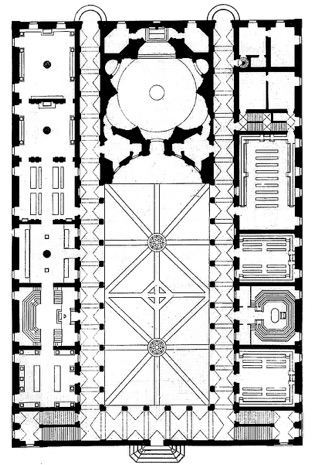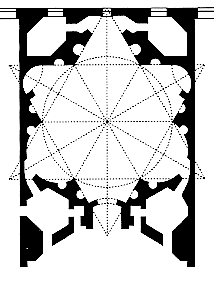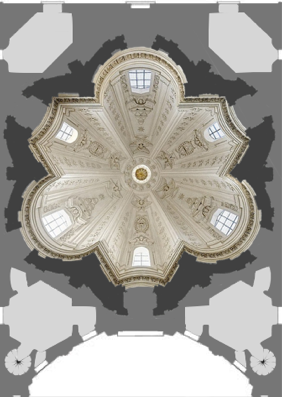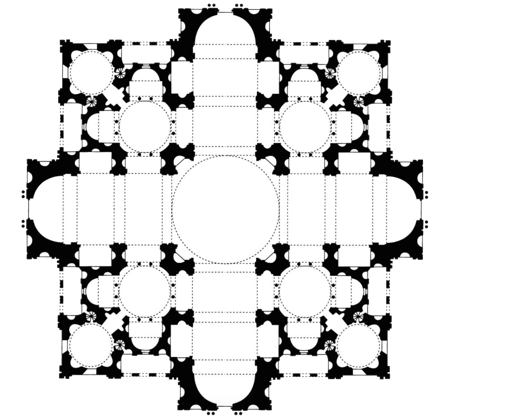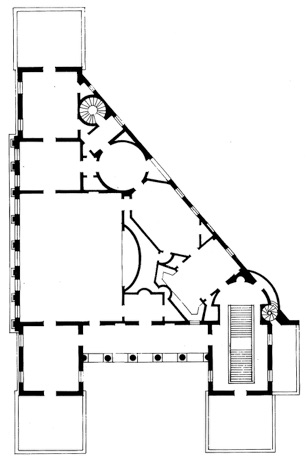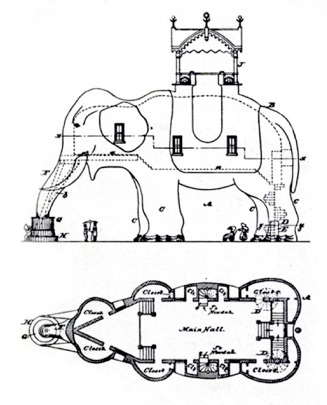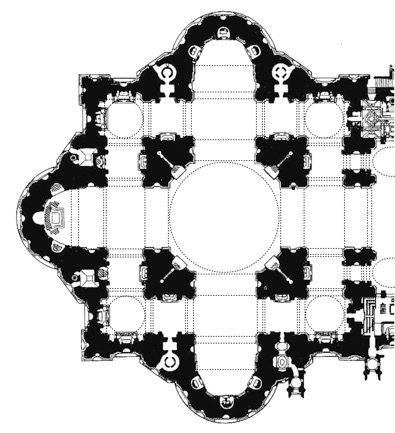Characteristics of Anti-Space
The loss of figural space as an intermediary structure between form and the observer has also left a vacuum in the process of seeing and interpreting our relationship to form. In anti-space there is a reduction in the equation of perception from three factors to two, whereas in the presence of volumetric space the identity of the space itself acts as a separate third term between a form and the observer, with each relating to it. The observer moves through space which the form itself creates. Form and space together act as a constellation, legible and integrated in a mutual relationship against which motion and navigation are measured through a fixed unchanging figure.
The destruction of space and its disassociation from form removes the constant third term in this perceptual relationship. When anti-space, as a freely moving continuous ground, becomes independent of form, it loses its value as a mutual reference. In a sense the location of space is reversed. Anti-space becomes associated primarily with the observer rather than with the forms which create it, so that architecture receives its vitality not from an integrated figure but only from a personal space which is mobile and individualized.
Relationships are perceived within anti-space as if it were a force field activated by the presence of isolated things: each object, in a sense, radiates its own influence animating the space so that mutual relationships are revealed primarily through the motion of the observer. We no longer move through a fixed space, but along with a fluid, moving one.
It has been the primary formal concern of Modern art and architecture to analyze this mode of perception and explore the appearance of form through movement and time. This analysis is exemplified by Cubism, where the transformations of shape and space derive from the movement of the viewer in the fluid, non-sequential medium of anti-space (see Box 5: Cubism - The Turning Point).
Cubism and Collage
From Cubism it is readily apparent that the following three anti-space characteristics have become provocative determinants of our perception of form in architecture: first, the interpretation of form as a relative state, its basic characteristics and appearances can be transformed by the events of moving and observing over time; second, the interpretation of solid mass as if it were both present and conceptually dematerialized by the permeation of space, or in a sense transparent; and third, the acceptance of the incompleteness of the collage compositional technique, that juxtaposes fragmented figures as a free-range method of finished composition.
The collage aspect of anti-space is particularly pertinent because it is both a characteristic compositional device and it represents the process of modern perception. The experience and meaning of formal relationships are known to the individual through non-sequential appearance, fragments of thought and assembled memories. This process of individualization of thought is itself the paradigm for collage.
In addition, collage, incorporated as a general attitude, promotes a critical and speculative relationship between the ideal and the real. It is a form of visual analysis. As in a collage “painting” the application of a real fragment onto the canvas challenges the painted image. It establishes a dialogue between fact and illusion, between real and ideal. With collage, useful attributes and partial references deriving from an ideal or utopian framework can be appropriated and used without accepting the whole premise of this position.
The capacity for simultaneous multiple viewpoints enabled through collage, offers a way out of the destructive dilemma inherent in the Anti-space/Space annihilation.
This attitude provides the means to incorporate multiple spatial typologies into architecture. It eliminates the necessity to accept the premise of a world of anti-space in order to use the valuable devices and perceptions which have emerged from it. It is not necessary to believe in a vast infinite flux as the only representation of the reality of space. There are two scales to our perception and knowledge—the vague reality of the expansive concepts of cosmological space and the specific reality of finite place and time. The collage process should be as applicable to the form of space as it is to the forms in anti-space.
The perceptual characteristics of anti-space allow us to understand that form can be perceived relative to its appearance through motion and time; that mass can be conceived as transparent, permeated with anti-space; that relationships can be established through fragments and the incompleteness of memory. These are conditions requiring further exploration. They are the lessons of anti-space we do not wish to unlearn, because once the image of form and the process of perception have been transformed by anti-space, a new conjunction of space and anti-space in architecture is possible.
Space: Negative and Positive
A new architecture of volumetric space, qualified and transposed into the context of modern perception and thin-wall construction can be made without traditional mass. But, it requires the transformation of our sensibility; embracing the enclosing plasticity of walls and accepting the existence of multiple spatial types. It also requires the identification of an inherent binary condition; Positive Space depends on a corresponding Negative Space.
What is Negative Space? It is the space within the walls. In general, the design of volumetric or positive space depends on the use of thick walls shaped so that the space formed on one side of the wall can be different, discrete, and independent from its opposite side. In the Villa Rotunda, 1571 (figure 3b) the four corner triangles of thick wall partly define three different positive spaces each, the center circle, a corner hall, and, a vestibule. These triangles appear as “solid” piers, defining space externally, but inside, they are empty. This is the negative space, set apart from, but creating the necessary backup for the larger geometric volumes. Negative space is occupied but experienced as a separate place here, in this case as a place for stairs. These empty triangles are like hidden pockets, within the building fabric.
The French word for pocket is poché. It is the term used for the areas of wall that are shaped to define the different positive spaces in a composition of rooms. When the wall is literally solid it is poché; when it is hollowed out and accessible it becomes negative space, also called habitable poché.
To illustrate the difference between an actual solid-wall architecture and negative space, we can imagine the transformation of the walls and piers of St Peter’s into negative space. The piers are, of course, the necessary structural solids supporting and defining the building’s massive vaulted and domed space. There is no negative space here because all is pure solid and void (figure 6). Suspending reality, for a moment, If one imagines the solids to be rebuilt in their exact present shape out of steel and light cladding so that empty space was also provided within the dimensions of the pier’s present thickness, then this void can be called negative space.
Bramante's earlier plan for St Peter’s (figure 7) creates, more directly, the conditions of negative space. The building is essentially a central cruciform void wrapped in a square, with the crotches between them “filled in” with a descending order of smaller spaces, a fabric of positive and negative conditions overlapping and nestled in each other. For example, the two triangular apses in back of the colonnaded squares act in two ways. One as subsidiary niches behind the colonnades, but second as the negative space backing up the solid rear wall of the exterior porches, which themselves are carved within the bounding square.
This formal idea is the same in both plans for Saint Peter’s, but Michelangelo, the sculptor, treats the whole as a solid plastic block, while Bramante, the architect, designs a fabric of woven voids, where space triumphs over mass.
-
7)Early Plan, St Peter’s Rome, Bramante, circa 1506.
From its integral presence in the thick walls of Bramante and Palladio, negative space has evolved into a useful contemporary form that provides independent overlapping places for a variety of uses.
At the neoclassical Caffè Pedrocchi in Padua, built in 1831 (figure 8), the pockets of negative space within the walls have expanded into a spreading realm of niches, anti-rooms, left-over closets, hidden chambers, and buried stairs. Positive spaces fill the plan, the whole enabled by the back-up of negative space, within the walls. The large meandering empty area of negative space in the middle of the plan behind the main hall is a residual precursor to modern flowing space. Here it both separates the main Sala Rossini from the diagonal enfilade of different rooms, but also joins them through a common backstage serving-pantry.
In a similar, more humorous illustration, the rectangular room inside Lucy the Elephant (figure 9) is created by hiding the inner skin behind a fattened thickness in the shoulders and stomach. Here, the empty thickness is filled with closets, storage, and ingeniously gives place for the main entrance stairs. This can be thought of as negative space.
This condition of negative space is not limited to the gaps between interior volumes. It can exist between the outside and inside of buildings as well, if the walls are shaped to form external urban spaces. In the Sapienza block, in central Rome, finished in 1660, Borromini inserted his spatially dynamic church of Sant’Ivo into the calm of Della Porta’s existing arcaded courtyard with a curved wall that terminated the court and gave a front to the church. These separate forms are welded together through the web of negative spaces that are cut into the surrounding fabric of walls. Here, imbedded within the thickness, are the subsidiary places for small chapels and wardrobe rooms in a complex ritual program integrated through the intrinsic concordance of positive and negative space (figure 10a-d).
Historically, the design of volumetric space inherently depends on the use of thick walls so that the shape of one space can be formed independent of the next, as in the Palazzo Barberini, where the oval space of the foyer is completely independent of the flat exterior surface of the facade. The Palazzo Barberini plan intentionally uses the hollow of the thick wall to produce two conditions of negative space, in the servant stairs and passages as well as in the rear public stair (see Box 6: Palazzo Barberini - Negative Space). The capacity of the wall to be formed differently on each side is the direct product of its thickness. Its inside and outside faces, being dimensionally separate, can act independently. Although today, we can no longer afford, or need, thick massive walls, the new capacity to build and define space with thin materials still allows us to make negative space according to the formal properties of the thick wall.
Thinness can be used to produce the illusion of thickness through the exploitation of precedents found in the architecture of volumetric space. We can have it both ways, solids and voids as places of occupation, space and anti-space separated by an empty, conceptually transparent mass. The work of John Soane is filled with intuitions of negative space. The vaulted ceilings of the Bank of England and the thick wall/facade of his own house suggest the possibilities of an architecture conceived in the formal principles of volumetric space and mass, but opened up by the actual thinness of its construction (see Box 7: The Invention of Virtual Thickness).
Negative space is the specific design of an apparent solid to serve the formation of space, both inside and outside itself. It is a condition of multiple appearances, looking like a solid boundary enclosing positive spatial rooms, but being empty creating another, simultaneous ,“hidden” place within itself.
The potential of this idea seems far-reaching. Space, geometric, volumetric and contained does not need to be discarded because of the prevalent anti-spatial world view. Space can be constructed next to, or within anti-space, if it is separated by the thickness and independent surfaces of a corollary condition that is negative space. “Free” plans using volumetric space can be composed by maintaining a boundary of virtual thickness, hollowed out to form the void in-between.
-
9)Lucy the Elephant, 1881, Margate, NJ, developed by James Lafferty, design by architect William Free.
-
8)Caffè Pedrocchi, Giuseppe Jappelli,1831, Padova, Italy.
-
10)c. Plan of the Dome.
The surrounding buffers of negative space in the base allow the complex energetic spatial interior of the chapel below to rise up as an inversion, from void to solid, emerging through the roof as a disengaged free-standing object into the forming space of the courtyard attic.
-
10)d. Detail plan of Sant’Ivo with subsidiary wardrobe rooms, and altars.
The plan is a proliferation of interlocking negative and positive spaces. Every piece of “wall” is carved away within the central Star of David chapel itself. Imagine moving into the private hexagonal chapels, through the walls and window wells, and up the tower stairs with their own windows in the most solid tip of building mass.
-
10)b. Plan of the Sapienza block.
The Church of Sant’Ivo is the focus of the entire composition. Even though it was built last, it totally integrates the surrounding arcades and courtyard engaging them through its four hexagonal corners in a web of negative space.
-
10)a. View of the Sapienza courtyard.
The Church of Sant’Ivo was inserted into Giacomo Della Porta’s existing building. Borromini placed the chapel behind a new curved end wall attached to the arcaded courtyard to establish a hollow “thick wall” condition of negative space that simultaneously defines both the horizontal court and the vertical chapel.




-
6)Partial Plan, St Peter’s Rome, Michelangelo, 1546.


5
6
7
8
